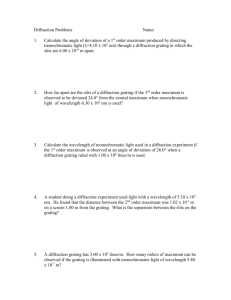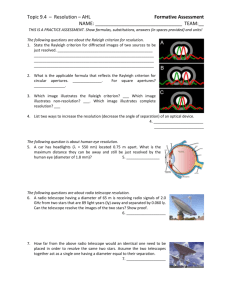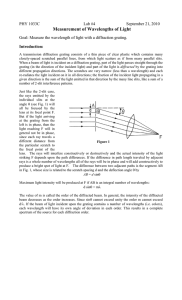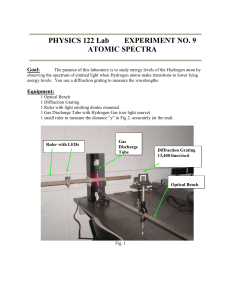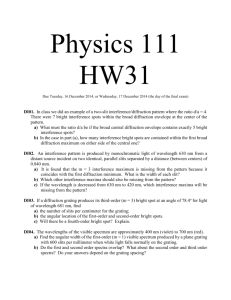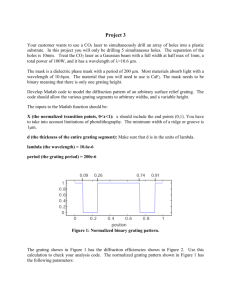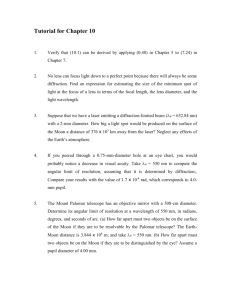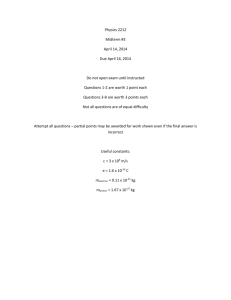L#11
advertisement
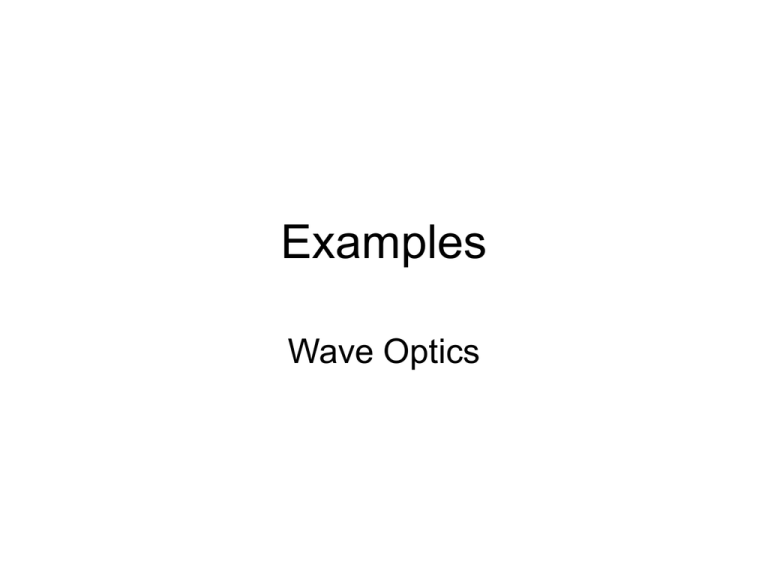
Examples Wave Optics 1- A double-slit experiment is set up using a helium-neon laser ( λ = 633 nm). Then a very thin piece of glass ( n= 1.50 ) is placed over one of the slits. Afterward, the central point on the screen is occupied by what had been the m = 10 dark fringe. How thick is the glass? For constructive interference: 2 x 0 2 m or 2 x For destructive interference: 2 2 x x 0 2( m 2 ) or 1 0 2 m 1 2 0 2 m 2- Light of wavelength 600 nm passes through a double slit and is viewed on a screen 2.0 m behind the slits. Each slit is 0.040 mm wide and they are separated by 0.200 mm. How many bright fringes are seen on the screen? 3- Light consisting of two nearly equal wavelengths λ +λ and λ, where λ << λ , is incident on a diffraction grating. The slit separation of the grating is d. A. Show that the angular separation of these two wavelengths in the mth order is d / m 2 2 b. sodium atoms emit light at 589.0 nm and 589.6 nm. What are the first-order and second-order angular separations ( in degrees) of these two wavelengths for a 600 line/mm grating? 4- The Figure shows two nearly overlapped intensity peaks of the sort you might produce with a diffraction grating . As a practical matter, two peaks can just barely be resolved if their spacing y equals the width w of each peak, where w is measured at half of the peak’s height. Two peaks closer together than w will merge into a single peak. We can use this idea to understand the resolution of diffraction grating. A. In small angle approximation, the position of the m=1 peak of diffraction grating falls at the same location as the m =1 fringe of a double slit: y1 = λL/d. Suppose two wavelengths differing by λ pass through a grating at the same time. Find an expression for y, the separation of their first-order peaks. B. We noted that the widths of the bright fringes are proportional to 1/N, where N is the number of slits in the grating. Let’s hypothesize that the fringe width is w = y1 / N. Show that this is true for the double-slit pattern. We’ll then assume it to be true as N increases. c. Use your results from parts a and b together with the idea that ymin = w to find an expression for λmin, the minimum wavelength separation ( in first order ) for which the diffraction fringes can barely be resolved. d. Ordinary hydrogen atoms emit red light with a wavelength of 656.45 nm. In deuterium, which is a “heavy” isotope of hydrogen, the wavelength is 656.27 nm. What is the minimum number of slits in a diffraction grating that can barely resolve these two wavelengths in the first-order diffraction pattern? 5. The Figure shows a plane wave approaching a diffraction grating at angle . a. Show that the angles m for constructive interference are given by the grating equation d sin m sin m , m 0 , 1, 2 ,...... Angles are considered positive if they are above the horizontal line, negative if below it. b. The two first-order maxima, m = +1 and m = -1, are no longer symmetrical about the center. Find 1 and -1 for 500 nm light incident on a 600 line/mm grating at = 30.

